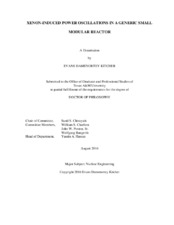| dc.contributor.advisor | Chirayath, Sunil S | |
| dc.creator | Kitcher, Evans Damenortey | |
| dc.date.accessioned | 2016-09-16T13:31:45Z | |
| dc.date.available | 2016-09-16T13:31:45Z | |
| dc.date.created | 2016-08 | |
| dc.date.issued | 2016-08-05 | |
| dc.date.submitted | August 2016 | |
| dc.identifier.uri | https://hdl.handle.net/1969.1/157767 | |
| dc.description.abstract | As world demand for energy continues to grow at unprecedented rates, the world energy portfolio of the future will inevitably include a nuclear energy contribution. It has been suggested that the Small Modular Reactor (SMR) could play a significant role in the spread of civilian nuclear technology to nations previously without nuclear energy. As part of the design process, the SMR design must be assessed for the threat to operations posed by xenon-induced power oscillations.
In this research, a generic SMR design was analyzed with respect to just such a threat. In order to do so, a multi-physics coupling routine was developed with MCNP/MCNPX as the neutronics solver. Thermal hydraulic assessments were performed using a single channel analysis tool developed in Python. Fuel and coolant temperature profiles were implemented in the form of temperature dependent fuel cross sections generated using the SIGACE code and reactor core coolant densities.
The Power Axial Offset (PAO) and Xenon Axial Offset (XAO) parameters were chosen to quantify any oscillatory behavior observed. The methodology was benchmarked against results from literature of startup tests performed at a four-loop PWR in Korea. The developed benchmark model replicated the pertinent features of the reactor within ten percent of the literature values. The results of the benchmark demonstrated that the developed methodology captured the desired phenomena accurately.
Subsequently, a high fidelity SMR core model was developed and assessed. Results of the analysis revealed an inherently stable SMR design at beginning of core life and end of core life under full-power and half-power conditions.
The effect of axial discretization, stochastic noise and convergence of the Monte Carlo tallies in the calculations of the PAO and XAO parameters was investigated. All were found to be quite small and the inherently stable nature of the core design with respect to xenon-induced power oscillations was confirmed.
Finally, a preliminary investigation into excess reactivity control options for the SMR design was conducted confirming the generally held notion that existing PWR control mechanisms can be used in iPWR SMRs with similar effectiveness. With the desire to operate the SMR under the boron free coolant condition, erbium oxide fuel integral burnable absorber rods were identified as a possible means to retain the dispersed absorber effect of soluble boron in the reactor coolant in replacement. | en |
| dc.format.mimetype | application/pdf | |
| dc.language.iso | en | |
| dc.subject | Xenon Oscillations | en |
| dc.subject | Small Modular Reactor | en |
| dc.subject | Multi-physics | en |
| dc.title | Xenon Induced Power Oscillations in a Generic Small Modular Reactor | en |
| dc.type | Thesis | en |
| thesis.degree.department | Nuclear Engineering | en |
| thesis.degree.discipline | Nuclear Engineering | en |
| thesis.degree.grantor | Texas A & M University | en |
| thesis.degree.name | Doctor of Philosophy | en |
| thesis.degree.level | Doctoral | en |
| dc.contributor.committeeMember | Charlton, William S | |
| dc.contributor.committeeMember | Poston, John W | |
| dc.contributor.committeeMember | Bangerth, Wolfgang | |
| dc.type.material | text | en |
| dc.date.updated | 2016-09-16T13:31:45Z | |
| local.etdauthor.orcid | 0000-0002-8581-9028 | |


